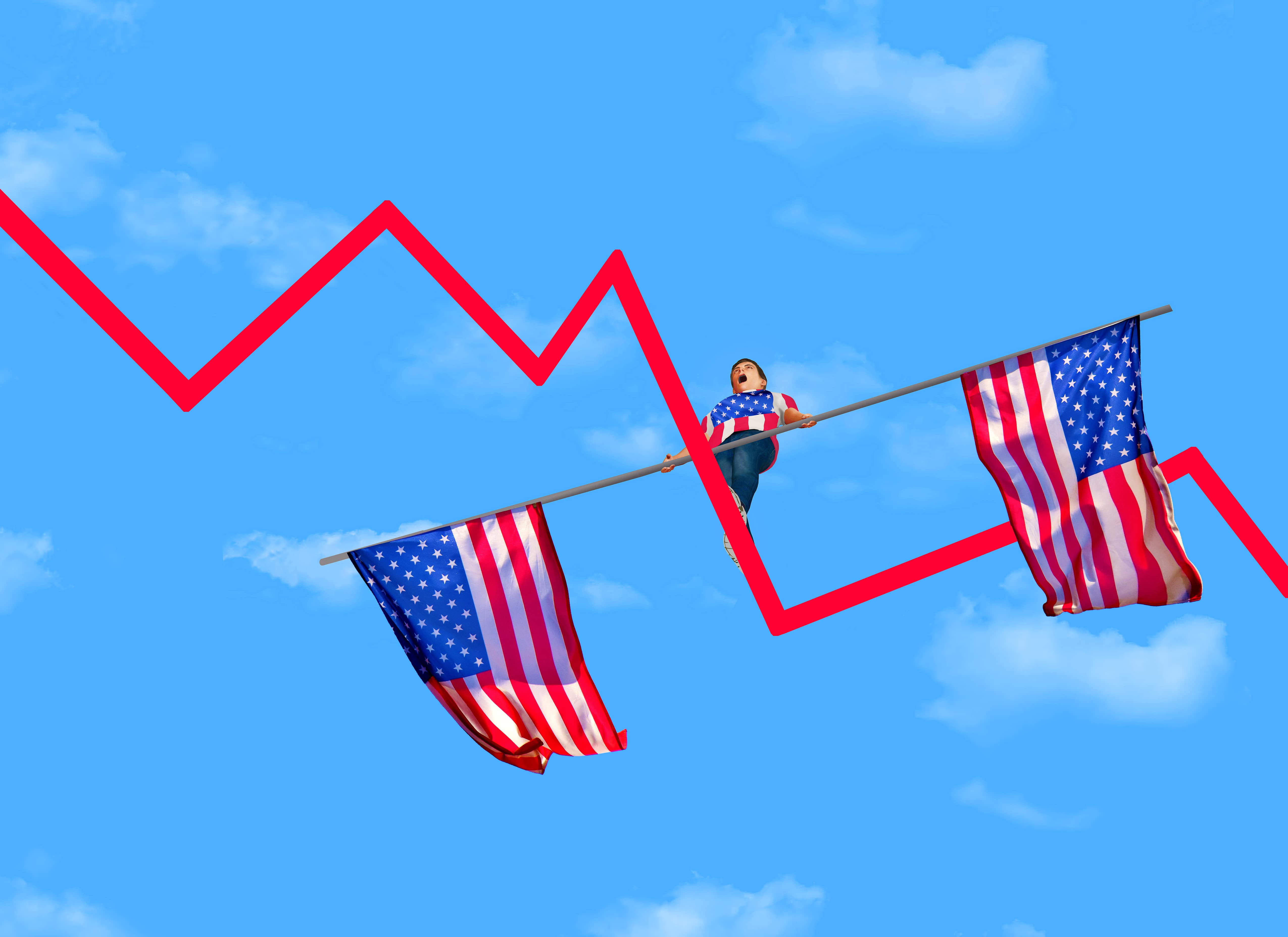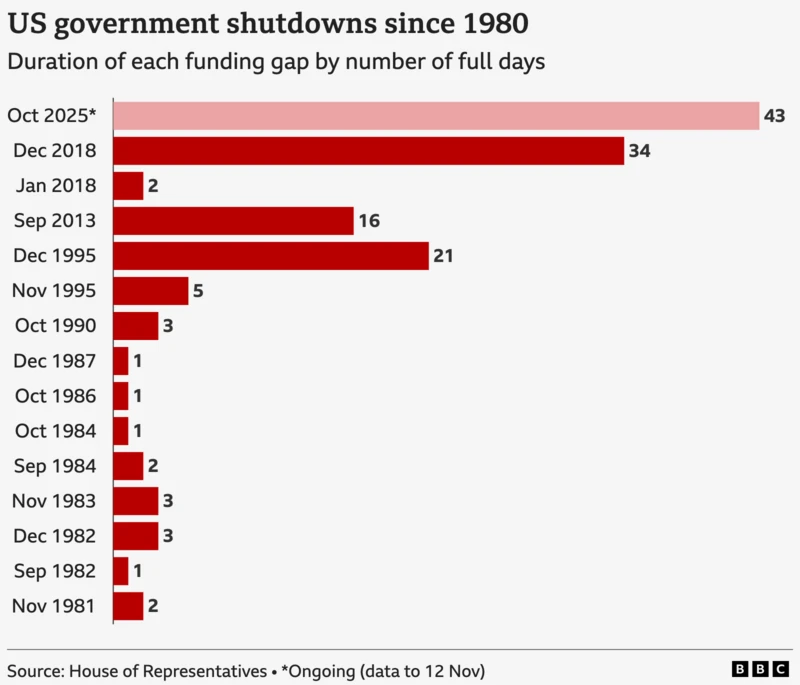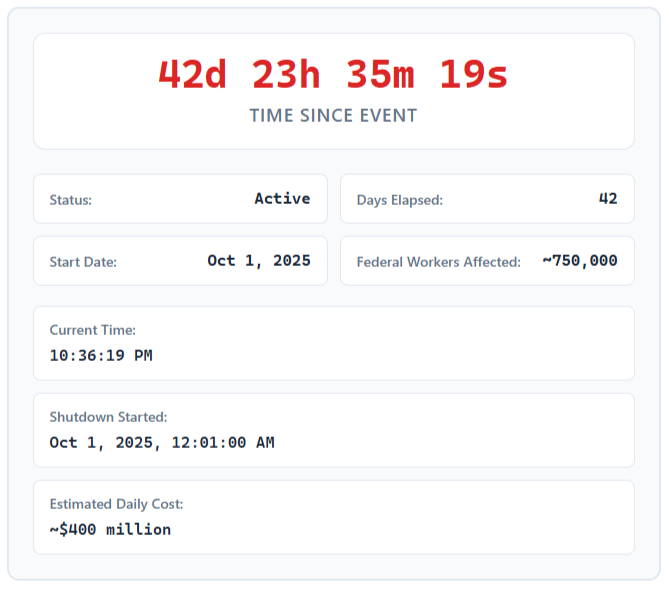市场资讯及洞察

The longest government shutdown in US history has finally ended after 42 long days.
After a month and a half of political theatre, seven Democrats and one independent broke ranks and voted with Republicans to pass a stopgap measure. The Senate went 60-40, the House followed 222-209, and Trump signed it hours later.
The legislation includes three-year appropriations for the Agriculture Department, FDA, military construction, veterans affairs, and congressional operations, along with restoration of pay for federal workers and reversal of Trump administration layoffs through January.
However, the most contentious issue, healthcare subsidies, has been kicked down the road to a December Senate vote.

COVID-era ACA subsidies expire at year-end. When they do, premiums for the average subsidised household will more than double from $888 to $1,904 per year, with an estimated 3.8 million people losing coverage entirely.
If the December vote fails, which is likely considering how far apart the two parties are on the topic, we could see a new shutdown begin in January.

What Happens Next?
This Week:
- Federal employees return to work.
- Paychecks start flowing again.
- SNAP benefits get restored for 42 million people, though heating assistance won't come back for weeks.
- National parks reopen.
- Airports start to go back to normal.
December:
- Senate votes on healthcare subsidies. It will probably fail.
- Premium notices continue to be sent showing 2026 costs doubling.
January 30:
- Government funding expires.
- We do this whole thing over, except now the healthcare subsidies have already expired.
- If Republicans and Democrats remain divided on budget priorities, another shutdown will likely begin.
By the Numbers:
Over the past 42 days, approximately 750,000 federal workers have been furloughed. Another two million worked without pay. Over 42 million had their food assistance delayed. And the FAA cut flights by 10% because air traffic controllers stopped showing up to work.

Further concern is the "data blackout" that has hampered Federal Reserve decision-making. Key economic indicators, including jobs reports, were suspended, leaving the Fed blind during an active rate-cutting cycle.
Meanwhile, separate analyses from Challenger, Gray & Christmas showed layoffs surged 183% in October, which would make it the worst October for jobs since 2003.
The Bottom Line
Today’s deal ended the shutdown, but it didn’t actually solve anything. The deal essentially kicks the can down the road to January while leaving the healthcare crisis unresolved.
With both parties divided on healthcare and spending priorities, and Trump lacking a comprehensive plan to address rising premiums and high deductibles, a resolution in the December vote seems unlikely.
If no compromise is accepted by the time Government funding expires on January 30, another shutdown is almost inevitable.
Impact of Australian Jobs Reports and U.S. Shutdown End on the Aussie


Apple Reports Third Quarter Results Apple announced its financial results for the June quarter after the closing bell on Tuesday. The Company reported revenue of $53.8 billion, which represents a 1% increase from the year-ago quarter. It is the first time in years that the iPhone revenue ($25.99bn) is less than half of Apple’s total revenue.
However, the strength of other Apple products has offset the weakness in the flagship product. “ This was our biggest June quarter ever — driven by all-time record revenue from Services, accelerating growth from Wearables, strong performance from iPad and Mac and significant improvement in iPhone trends,” said Tim Cook, Apple’s CEO. The iPhone business is struggling as consumers are upgrading less often which is prompting Apple to focus on its consumer services like iCloud, the App Store, Apple Music, Apple Pay for diversification and growth. Wearables like Apple Watch, AirPods, and Beats headphones are also products that are growing at an accelerating rate.
The CEO has the tough job of maintaining interest in Apple into the post-iPhone era. The popularity of iPhones is not the same as it used to be. In the last few years, the company reported its first iPhone sales drop and earlier this year, they issued a rare warning that the first-quarter earnings will be weaker than previously expected.
After reaching its peak in early 2018, its share price had been under pressure throughout 2018. After a strong recovery since the beginning of the year, the stock plunged throughout the month of May. Source: Bloomberg Terminal Its share price is close to recouping losses made in May.
After the release of the quarterly updates, Apple’s share price rose more than 4% in the after-hours trading. Apple is providing the following guidance for its fiscal 2019 fourth quarter: revenue between $61 billion and $64 billion gross margin between 37.5 per cent and 38.5 per cent operating expenses between $8.7 billion and $8.8 billion other income/(expense) of $200 million tax rate of approximately 16.5 per cent Click here for more information on trading Share CFDs, also, see our Index Trading page for information in trading Indicies.


Apple Inc. and Amazon.com, Inc The last two of the five most prominent technology companies, Apple Inc. (AAPL) and Amazon (AMZN), which form part of the FAANG group, have reported interesting quarterly earnings and highlighted their actions during this unprecedented uncertainty. Apple Inc. The company missed on earnings estimates but reported better-than-expected revenue: Earnings Per Share (adjusted): $2.55 (up by 4% from the year-ago quarter) Quarterly Revenue: $58.3B (up by 1% from the year-ago quarter) iPad, iPhone, and Mac all reported a decrease (year-on-year) of 10%, 7%, and 3%, respectively.
The shortfall was compensated by strong performance in the services and wearables category. The pandemic-induced environment has driven revenue for Services to an all-time high and a quarterly record for Wearables. Net sales by category: Three Months Ended March 28, 2020 $ (in millions) Three Months Ended March 30, 2020 $ (in millions) iPhone $28,962 $31,051 Mac 5,351 5,513 iPad 4,368 4,872 Wearables, Home and Accessories 6,284 5,129 Services 13,348 11,450 Total Net Sales $58,313 $58,015 The current crisis has made the stock cheaper, and as widely expected, the board has also authorised an increase to the existing share repurchase program despite the uncertain environment.
However, investors took note of an increase of only $50B compared to the forecasted amount of $75B-$100B. In the month of April, the company’s share price substantially pared the losses seen since February 2020. Its stock price rallied by more than 20% this month and is currently trading at $293.80.
After the release of the results, the company’s share price fell by around 2% in after-hours trading. Source: Bloomberg Amazon.com, Inc. Amazon, the leading e-commerce retailer, has also reported its first quarterly earnings after the bell on Thursday: Earnings Per Share (adjusted): $5.01 (down by 19% from the year-ago quarter) Quarterly Revenue: $75.45B (up by 26% from the year-ago quarter) While the founder and CEO provided an upbeat outlook of how Amazon has navigated through the current crisis with the availability and adaptability of different products from online shopping to Amazon Web Series to Prime Video and Fire TV, many investors focused on the company’s intentions to use Q2 operating profit for COVID-related expenses: “If you are a shareowner in Amazon, you may want to take a seat, because we’re not thinking small.
Under normal circumstances, in this coming Q2, we would expect to make some $4 billion or more in operating profit. But these are not normal circumstances. Instead, we expect to spend the entirety of that $4 billion, and perhaps a bit more, on COVID-related expenses getting products to customers and keeping employees safe.” The company’s share price rose by nearly 30% in April, pairing all the losses made towards the end of February and in March.
As of writing, the share is currently trading at $2,474. Source: Bloomberg After the release of the results, the company’s share price tumbled by around 5% in after-hours trading.


After a turbulent year for the technology giants, Amazon was crowned leader of the technology sector by market capitalisation on Monday. It has surpassed Microsoft to become the “ New King in Town ”. Technology stocks have been the primary driver of the global stock markets in the past decade.
The overall performance of the tech sector was outstanding since the financial crisis. However, 2018 has shown us that the tech giants are facing their own unique challenges and went into a freefall. In September 2018, Amazon reached the 1 Trillion Club (please link words to this article- https://www.gomarkets.com/au/review-of-year-2018/) just over a month after Apple reached the same milestone.
Since reaching this historic high, Amazon’s share price has dropped and dipped below the $700bn market cap in December 2018. Apple, Amazon, Google and Microsoft had been trading on a clear uptrend chart in the past decade, but 2018 took them all on a bumpy ride. The below charts depicts the performance of the four tech giants: 5-Years: The performance of these tech growth stocks has been impressive which explains why they were the favourite investments for the past decade. 1 -Year: Out of the four, only Amazon and Microsoft managed to stay in positive territory.
Year-to-date: Apple is the only one on the back foot despite more optimism in the air. Apple’s CEO issued a rare revenue warning that is undermining its recovery. What’s next for these tech stocks?
Volatility has been the dominating theme in 2018 and fears have hit stocks hard. After a painful end in 2018, it was a better start for stocks than anticipated. These stocks are expected to bounce back during the course of 2019.
However, investors will be more careful in their positionings as the strong confidence in the FAANG group has somewhat faltered.


All Eyes on Jackson Hole Economic Symposium The annual Jackson Hole Economic Symposium is sponsored by the Federal Reserve of Kansas City and is annually held in Wyoming. It is an exclusive central bank conference which fosters open discussions on global policy matters. The event is closely watched by market participants and has the potential to affect the stock and currency markets.
A Pivotal Moment for Volatile Markets There is no doubt that this event will likely be the most important one for the global markets this week. However, what makes it more special and relevant this year is how appropriately the title “Challenges for Monetary Policy” reflects the reality of the recent challenges faced by policymakers. Investors have been navigating in an extremely volatile environment in the past few weeks, gripped by mounting worries of recession and trade tensions that are threatening the harmony of the global trade system.
Challenges for Monetary Policy Ten years after the financial crisis, monetary policymakers are forced to look back and assess the challenges of normalising monetary policies. Over the years, central banks across the globe have used both conventional and unconventional monetary policies to support their domestic economy in the face of the financial crisis. However, the current headwinds and inflation dynamics are making it difficult for policymakers to chart a course of monetary policy and begin removing policy accommodation.
Only a year ago, central bankers were talking about rising interest rates. A global slowing economy on top of trade tensions is forcing them to seek refuge with more easing monetary policies. Despite steady economic growth over the years, global interest rates have not been able to return to levels seen before the financial crisis. “Midcycle Adjustment” Market participants are eagerly waiting for the Federal Reserve Chairman, Jerome Powell, to deliver its speech on Friday.
The July rate cut was less-dovish than anticipated as the Fed Chair surprised the markets with a “midcycle” adjustment. A lot has happened since his last remark. We saw recession fears crawling back in the financial markets which triggered a rout in the stock market, and a rally in the bond market.
The 2-Yr US government bonds dropped below the 10-Yr yields for the first time since the financial crisis. The 30yr Treasury Yield also briefly fell to a record low. The Symposium will help market participants assess and process the meaning of “midcycle” and see if the Fed will adjust their remarks following the recent developments in the markets.
Investors are also hopeful to see the comments on the recession risk. So when Jerome Powell delivers his annual speech at Jackson Hole this Friday, he can either calm nerves or create more panic.


The Australian share market struggled to edge higher despite overnight gains on Wall Street. The S&P/ASX200 dropped on the open after a two-day advance as all three US equity benchmarks had pared gains in the final hours of trading dragged by dovish Fed comments. In the afternoon, the index was down 37 points or 0.70% to 5,370.
All Ordinaries was trading lower by 28 points or 0.51% to 5,450. The majority of the sectors were trading in negative territory but significant losses of more than 1% were seen in the real estate and financial sectors. Bank stocks were heavily weighing on the index with Westpac, ANZ and NAB all down by 2% or more, while CBA was trading around 1% lower.
Source: Bloomberg As of writing, the energy sector was the best-performing sector, supported by a surge in crude oil prices. For the first time since April, Brent Crude oil futures rose above $30 as production cuts started kicking in. Source: Bloomberg On the economic front, the Aussie Retail Sales turnover came above expectations at 8.5% in March compared to the 8.2% forecasted.
Australia saw both record rises in food retailing and record falls in cafes, restaurants and takeaway food services. Panic-buying has driven the increases in food retailing (24.1%), household goods retailing (9.1%) and other retailing (16.6%) which has helped to compensate for the significant drop in other categories. The Aussie dollar remains relatively muted at 64.30 US cents, despite the upbeat Retail Sales data.


A Cautious Fed FOMC Meeting Investors were eagerly looking forward to the Fed’s statement and forecasts for clues on how the Fed is viewing the health of the economy after easing lockdown measures. Global central banks have played a crucial part in absorbing the pandemic-induced shocks in the global economy. Together with huge fiscal intervention, central bankers have swiftly deployed various monetary tools to keep credit flowing and provide support to businesses and households.
Dot Plots Even though the financial conditions have improved from the support of the policy measures that was put in place, the Fed highlighted that the ongoing health crisis will continue to weigh on the economic activity, employment, and inflation in the near- term and may pose considerable risks for the medium-term outlook. On Wednesday, the Fed decided to maintain the target range for the federal funds rate at 0 to 0.25%. “The Committee expects to maintain this target range until it is confident that the economy has weathered recent events and is on track to achieve its maximum employment and price stability goals.” Most importantly, market participants took note that the US interest rates will stay near to zero through 2022, ruling out the probability of raising rates anytime soon and a V-shaped recovery for the US economy. Economic Projections The Fed refrained from providing any forecasts during the pandemic given the tremendous uncertainties about the economic outlook.
Much attention was, therefore, on the interest rate and economic forecasts. Gross Domestic Product: The Fed is expecting a contraction of 6.5% in 2020, followed by an expansion of 5% in 2021 and 3.5% in 2022. Unemployment Rate: The outlook for employment is also gloomy.
After the US labour market experienced its worst monthly drop in history, the Fed is forecasting that the unemployment rate will reach a high of 9.3% by the end of 2020. Inflation: The Fed sees anaemic inflation which will remain below the target rate of 2% for the next three years. The Long Road to Recovery Markets are taking note of the long road to recovery following the FOMC meeting.
US stocks retreated as the Fed’s comments and forecasts show that they will continue to loosen monetary policy. Shares in Asia also struggled to edge higher following a cautious Fed on Thursday. World Equity Indices (% Change) Source: Bloomberg Terminal As of writing, the US and European stock futures slumped in the wake of the Fed’s decision.
Gold A dovish-Fed have pushed the precious metal to a high around the $1,740 level. Gold has been trading sideways within a $70 range amid the reopening of economies, geopolitical risks and a weaker US dollar as traders were waiting for the next biggest catalyst.

